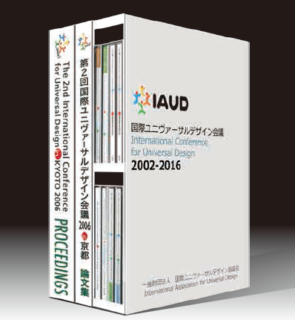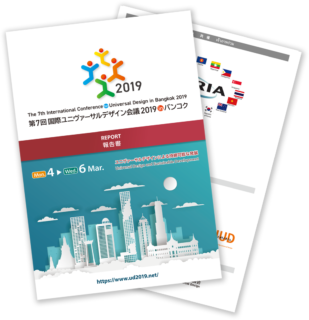2025.05.29
Day 2: October 13 (Saturday)
2012.10.20 Updated
Session 1: Global Development of Universal Design
With Ms. Onny Eikhaug coordinating the session, Mr. Francesc Aragall gave a presentation on UD and Dr. Rama Gheerawo gave a presentation on Inclusive Design. Both speakers used examples to explain the differences in the two concepts but agreed that it was necessary to focus on common areas and take a more integrated approach in order to achieve the same objectives using UD as the tool. They vowed to announce the results of their discussions at the closing ceremony. During the question and answer time, IAUD Managing Director Kawahara also provided an explanation to the audience about the background and objectives of this session.

Onny Eikhaug (Program Leader, Norway Design Council, Norway)

Francesc Aragall (President, Design for All Foundation: Spain)

Rama Gheerawo (Deputy Director, Helen Hamlyn Centre for Design, Royal College of Art: UK)

Scene at the conference venue

Discussion by the three speakers
Session 2: Overcoming the Great East Japan Earthquake disaster

Conference presentation

Isoo Sasaki (Mayor of Natori, Miyagi Prefecture: Japan)
- Mayor Sasaki talked about the earthquake/tsunami disaster and how the tsunami hit his town 1 hour and 5 minutes after the occurrence of the earthquake.
- He also talked about methods used to obtain information after the disaster in order of priority (1st: radio, 2nd: family members and neighbors, 3rd: television)
- He also cited issues in responding to disasters and stated that the means of communication must be: easy to understand, low tech, and use VHF low band radio.

Tetsuharu Sugawa (Former Executive Director, Genkaijima Reconstruction Urban Planning Development Bureau, Fukuoka City: Japan)
- 3 years have passed since the disaster
- Building a relationship of trust with the local community
- Presence of recovery committees

Srinivasa Popuri (Senior Human Settlements Officer, UN-Habitat: Japan)
- Activity programs after disaster and during recovery (established in 1997)
- Asia-Pacific Office is located in Fukuoka
- Training and approaches for prevention

Miho Mazereeuw (Lecturer, Massachusetts Institute of Technology)
- Presentation of ideas for reconstruction projects
Luncheon Seminar:
Special seminar for companies to introduce their UD policy and examples of UD during lunch

Kao Corporation

Panasonic Corporation

Tanseisha Co., Ltd.
Open Seminar/Session 3: Rescue and Survival ― UD in Disaster Operation
Presentations in this session covered UD in rescue and disaster mobilization from the perspective of land, sea and air operations and gave the audience a clear understanding of the differences in the functions and roles of the respective operations. It was very impressive that the presenters gave their explanations from the viewpoint of universal design, reaffirming the importance of the human aspect in tackling issues.
Mr. Minoru Tomii (Major General, Commanding General of the 5th Engineer Brigade, and Garrison Commander of Camp Ogori, JGSDF: Japan)
This disaster was characterized by its compound nature, an earthquake followed by a tsunami and nuclear plant disaster
Response timeline: Saving lives >>Search for missing persons >> Support in everyday living >> Preparation of housing sites
Humanistic approach based on UD
Activities to better understand the situation of the disaster victims
- Personal inquiries: taking time to find out and respond to problems of each individual
- Women-for-women team: Women responding to women's needs (providing sanitary items, cosmetics for preventing dry skin)
- Listeners' unit: Responding to people in local dialects (= universal dialogue)
- Sorting emergency relief supply: Female members participating in sorting and cataloguing emergency relief supplies
Mr. Shoichi Yonemaru (Inspector General, Headquarters Sasebo District, MSDF: Japan)
Fleet Escort Force: Characteristics of rescue by sea (surrounded by sea on all sides)
- Responding to situations when approach by land is not possible, ability of remaining as an independent force for an extended period of time, smaller vessels conducting operations in small sea areas, demonstration of mobility in responding to wide-area emergencies
- Main operational duties: Transporting supplies, resupplying, saving lives, port investigation
Mr. Masaki Sugiyama (Major General, Vice Commander Western Air Defense Force, JASDF: Japan)
- Foremost operation: To secure airstrips
- Response timeline: Transport corpses >> transport support units >> intensive search/rescue >> support in everyday living (cooking, bathing) >> support in organizing supplies
Summary
System of order and command
- Ground Self Defense Force/ Maritime Self-Defense Force/ Air Self-Defense Force
Respective operations based on assisting disaster victims
- Clarification of areas (districts) of responsibility
- When communication is cut off: act within the assumed scope of responsibility
Care for force members
- Measures to reduce psychological burden for younger members of the force
- Evening group discussions (about 10 members) to share events and experiences of the day
- Effective for reducing the psychological burden of the unit members
- Capability recovery center
- Establishment of bases away from disaster areas (temporary refuge) and allow respite for immediacy (approximately 4 hours' transport)
- Effective in spiritual healing
- Evening group discussions (about 10 members) to share events and experiences of the day

Scenes from the session

From right: Major General Tomii (JGSDF), Inspector General Yonemaru (JMSDF) and Major General Sugiyama (JASDF)

Scene from the visit of the late HIH Prince Tomohito to disaster areas
Open Seminar/Session 4: Safety and Security – UD in Public Safety and Disaster Prevention

Representatives from the Japan Coast Guard, Fukuoka City Fire Prevention Bureau, and Fukuoka Prefectural Police Headquarters gave presentations on the division of roles and the activities of their respective organizations

Yoshikazu Ota (Director, Guard and Rescue Department 7th Regional Coast Guard Headquarters, Japan Coast Guard)
- Ensuring safety and security, maritime rescue, enforcement of laws and policing
- Disaster readiness: "listening to people requiring rescue," "how to reach people requiring rescue," "what procedures to take (transport? administer treatment?)
- Reporting: dial 118 (on a par with 110 for Police and 119 for Fire Department)

Kenji Fujiwara (1st Assistant Chief, Director of Fire Suppression, Fukuoka City Fire Prevention Bureau)
- No. 1 in Japan in ambulance service response time
- Fire Organization Act: strengthening of support system and cooperation; city >> prefecture >> national government)
* During the Great East Japan Earthquake disaster, 44 prefectures excluding the three prefectures in disaster areas provided support. - Time limit: 72 hours

Kazutoshi Shibata (Supervisor, Security Division, Security Department, Fukuoka Prefecture Police)
- Called to action in the area affected by the Great East Japan Earthquake Disaster (searching for missing people, traffic checks, patrolling, etc.)
- Took into consideration of the importance of prior preparations and health management of force members
- Interaction with local people was a source of encouragement
Safeguarding one's own life without relying on others is important in the psychological readiness of people in local communities, and local communities must take action before we arrive. In other words, the procedures to follow are "self-help, mutual help, and public help," in that order. Public help essentially means relying on government for reconstruction efforts.
Although various organizations do their best to cooperate in activities such as rescue efforts, disaster prevention, and maintaining security, we expect local communities to do their part as well. Obtaining accurate information, making decisions and taking action form the basis of informed responses to risks related to timing and circumstances.
Open Seminar/Session 5: Creating a Safe and Secure Society

With Ms. Hatoko Shimizu (photo on right, Counselor, SHUFUREN) acting as coordinator, municipal government officials spoke about what responses the municipal government expects of people in the local community when a disaster occurs, the kinds of things they should prepare on a routine basis, and desired improvements in the future and suggestions for improvement from the viewpoint of UD. Each official addressed these areas in light of the particular circumstances in their municipal area.

Saga Governor Yasushi Furukawa

Kumamoto Ex-governor Yoshiko Shiotani

Fukuoka Mayor Soichiro Takashima
UD Workshop: Business and Design: What is Human-centered Design Approach?
Lecturers: Rama Gheerawo, Onny Eikhaug, Francesc Aragall
Designers from all countries participated in this workshop for experiencing UD methods first hand. Deciding to whom questions should be asked and on which aspects to focus are very important in UD. We emphasized drawing rich inspiration from a small number of people instead as addressing questions to a large number of people. A team of approximately six people developed ideas for resolving problems using imaginative thinking and presented their ideas to each other using photos taken in the homes of the actual users. The presentations were very stimulating, enjoyable, and full of new experiences, and the three lecturers gave words of praise to the workshop participants.

Overall scene

Team instruction

Presentation

Lecturers
Back to Day 1 << Index >> to Day 3
Inquiries
![]() Please make your inquiry here (you will be automatically transferred to the Inquiries page).
Please make your inquiry here (you will be automatically transferred to the Inquiries page).








